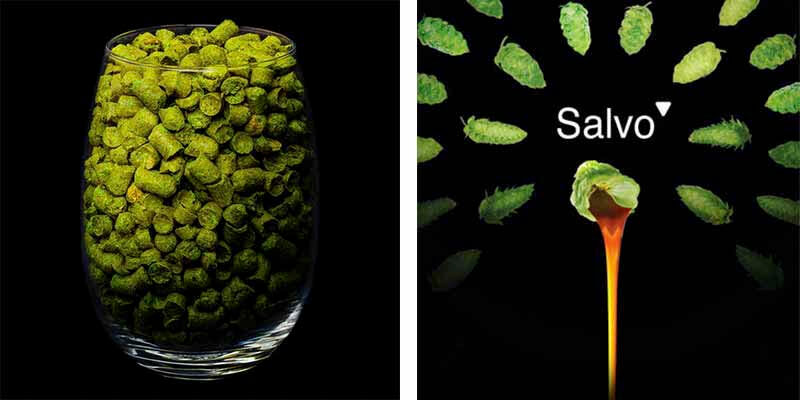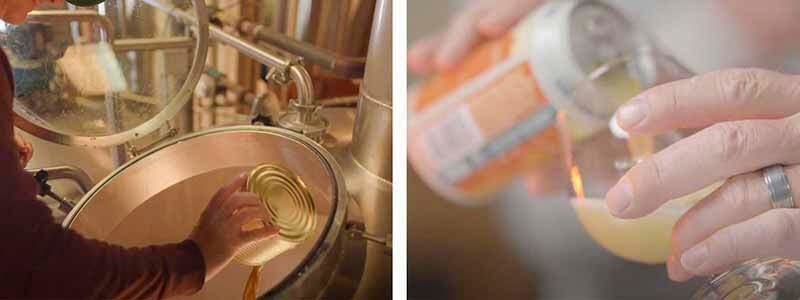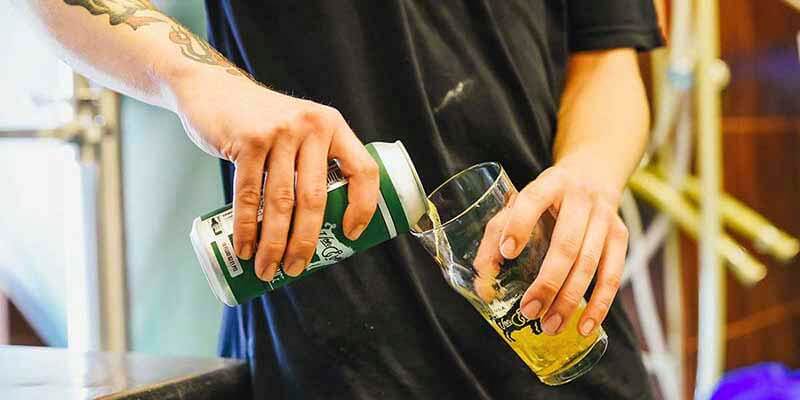While we’ve already extensively covered new alpha acid-based hop products such as SPECTRUM and Incognito, Salvo™ is a bit different because it focuses exclusively on extracting the beta acids in hops.
With the ability to add a huge punch of aroma and very little to none of the bitterness, Salvo is a great pourable alternative for brewers looking for a dry hop replacement or supplement.
Like any new hop products there can be some nuances with using these outputs, so we sat down with brewers at Von Ebert Brewing and New Belgium to get their take on the best advantages of Salvo, where to use Salvo in the brewing process, and a couple great examples of beers they’ve made with Salvo.
(Above image courtesy of Hopsteiner)
What We’ll Cover in This Piece:
What Is Salvo?
A pourable CO2 hop extract from Hopsteiner, Salvo is almost like hop molasses—thick and viscous with a dark amber almost burnt-sugar color.
Whereas other hop products such as Incognito and SPECTRUM focus on alpha acids, Salvo predominantly emphasizes essential hop oils and beta acids.
It’s this approach that truly sets Salvo apart from other hop products on the market.
“It’s different from anything we’ve ever used before,” says Sam Pecoraro, head brewer at Von Ebert Brewing, who has made around eight or nine beers with Salvo. “The big surprise was how different it is than an alpha plus oil extract. Being just beta and oils we didn’t really understand what kind of impact it would have and it’s been pretty intense.”
Designed to add a huge boost of aroma intensity, Salvo seems to successfully deliver on its promise.
“It’s almost like having a more impactful dry hop but with a hot-side addition,” says Pecoraro.
Similarly, Ramon Tamayo, brewing manager at New Belgium Brewing’s San Francisco taproom and Magnolia Brewing Co., has found Salvo to be a really interesting product. He’s already brewed somewhere between thirty to forty different beers with this new hop product. “They took the alpha acids out of it, so it’s just pure aroma, very minimal bitterness, and none of that vegetative flavor,” he says.
For all those reasons and more Salvo has caught the attention of brewers across the country.
The Top 5 Advantages of Brewing With Salvo

Image courtesy of Hopsteiner
Much like other hop products out there, Salvo has some distinct brewing advantages.
1. Higher Yield
Since Salvo is a pourable beta extract with no vegetative material, it can actually help mitigate beer loss.
Whereas before a higher concentration of traditional T-90 pellets would naturally soak up some of your batch, Salvo removes that barrier, meaning you will end up with a higher final yield.
As best practice, Hopsteiner recommends that you use Salvo as a partial replacement for whole-cone or pellet hops, not necessarily as a complete substitute for dry hopping.
“I don’t think it’s a sub for dry hopping,” says Pecoraro. “We haven’t found that yet…but it does give a boost to our dry hop.”
Similarly, Tamayo has found that while “it’s nice that you’re cutting out some extra vegetative matter that results in getting more beer in the end product,” the true advantages come from the flavor and aroma boost.
2. Better Aroma in the Finished Beer
Ultimately, with all of these products the main advantages are pumping up the flavor and aroma of your beers without using as many ingredients. Or at least without using as many ingredients like hops that may detract from the final yield of your batch or increase the cost of the final beer.
More beer that smells and tastes better is a pretty great proposition. But does Salvo live up to the hype?
Short answer: Yes.
“The main attraction for me with Salvo isn’t not putting in other hops,” says Tamayo, who mentions that when brewing with Salvo he actually still adds a combination of pellets, Cryo hops, or T-90s depending on the recipe. “Any time you can max your yield is always good, but just packing in aroma, that’s the best part. You’re making these beers pop even more.”
Since the alpha acids have been removed from Salvo, this product can really be used to enhance aroma without worrying about imparting extra bitterness into a beer.
“There are a lot of advantages to [Salvo], including getting a more stable aroma and flavor pop from a hot-side CO2 extract,” says Pecoraro.

Image courtesy of Hopsteiner
3. Save on Costly Ingredients Such as Hops
It’s no secret that hops can be expensive. Hop products like Salvo that are meant to replace a portion of your traditional T-90 pellets can help you save money in the brewhouse in a couple different ways.
First, if you’re replacing traditional pellets with Salvo, you can save those T-90s for use in another batch.
Second, the cost of Salvo itself is very reasonable. “The cost effectiveness is fantastic,” says Pecoraro. “I feel like we’re getting about an 11lb impact or the equivalent of adding 11lbs of T-90 and you’re looking at under $4 a pound.”
Contact Hopsteiner here for the most up-to-date pricing on Salvo.
4. Increased Shelf Stability
Perhaps not the most marketed benefit, shelf stability of a beer seems to increase when brewed with Salvo.
It’s something Pecoraro found in his own experiments at Von Ebert. “[Salvo] is a fantastic stabilizer,” he says. “Not only does it give a boost to our dry hop, but it stays around a lot longer and the shelf stability is fantastic on it.”
According to Pecoraro, they’ve actually held back small format kegs for up to six months, discovering they can still taste Salvo’s impact in the beer after a sustained period of time, whereas everything else drops off.
“From a business side it’s a great tool to increase shelf stability,” says Pecoraro.
5. Save on Shipping and Storage
Since Salvo comes in 0.5kg to 4kg cans, you can save on shipping costs and storage space.
“Having a case of twelve or twenty-four Salvo cans is a lot different than boxes and boxes of hops,” says Pecoraro. “It’s a lot cheaper and storability is better.”
The Best Way to Brew With Salvo
The two most important things you’ll need to consider when brewing with Salvo are how to make it workable and where to add it in your brewing process. Many of these answers will be dependent on what works best for you and the current brewing setup you have.

Image courtesy of Von Ebert Brewing | Hopsteiner | Craft Beer & Brewing
How to Dose
Both Pecoraro and Tamayo say that because Salvo is so viscous you need to preheat it beforehand in order to work with it.
If you’re a bigger brewery, you may have a hop doser that you can flow hot wort through and just drop the whole tin of Salvo in to simultaneously melt the CO2 extract and get into solution nicely.
If you’re a smaller brewery with less equipment, you might have to get a bit more creative to make Salvo workable.
At Von Ebert, Pecoraro pours some hot liquor into Salvo for an hour or so before popping and pouring it into Von Ebert’s kettle/whirlpool combo.
At New Belgium, Tamayo has a fairly small setup, so he has his own workaround.
“Basically, we end up pouring the can into these smaller, squatter circular kitchen tubs…so we can maximize the surface area to get it hotter and get that liquid a bit faster,” he says. “We pull hot water out of the coffee maker that is almost near boiling and then we soak it in there to get it all warm, mix it up, just homogenize it a bit, and then measure it.”
Once you have a workable product the next question is: When and where do you add it during the brewing process?

Image courtesy of Crystal Lake Brewing | Hopsteiner | Craft Beer & Brewing
When and Where to Dose: Kettle/Whirlpool vs Fermenter
According to Hopsteiner, “Salvo is best used as a late kettle/whirlpool addition to partially replace leaf or pellet hops.”
And you can certainly dose it this way. For example, Pecoraro says they’ve found the most success by adding Salvo into their kettle/whirlpool combo with a couple minutes left in the boil.
“We found that with this combination there is not quite the turbulence there would be with a dedicated whirlpool,” he says, mentioning they do worry that Salvo will stick to the side walls if there isn’t a proper amount of agitation to mix it into solution. “We have had a ton of success putting [Salvo] in right at the end of boil.”
But for others the kettle/whirlpool hasn’t been the best place to dose Salvo.
For instance, at New Belgium’s San Francisco brewhouse where Tamayo actually faced a lot of challenges with adding Salvo into the kettle.
“We would find all the time that you could see the slicks of Salvo sitting there on the top,” says Tamayo. “They just weren’t getting fully incorporated no matter how hard we spun our whirlpool or what time we added before the whirlpool started.”
The solution?
Tamayo asked around to other brewers who had worked with Salvo and discovered that they found success putting the hop product directly into the fermenter.
So Tamayo gave it a shot, knocking out the flowable, pre-heated Salvo right into the fermenter.
“We leave it hot so we won’t turn on the heat exchanger,” says Tamayo. “But once we get enough in there we start cooling the liquid back down to pitching temp for our yeast and then start hitting it with oxygen because you don’t want to start oxygenating warm liquid.”
The technique worked. “You can see it flowing in there and just melting,” says Tamayo. “You’re getting the most in there, you’re getting aromas into the liquid you want.”
Tamayo points out another additional benefit to adding Salvo into the fermenter. “You’ll see a little bit of slick on top, but that’s just those oils floating there,” he says. “Later in the process a benefit of that is a little bit of that oil will keep the fermentation krausen from blowing up. When that happens a lot of those beautiful aromatic oils are getting out of suspension…so that little bit of oil slick is nice [because]…it keeps that foam low and all of that hoppy goodness in there.”
The overall takeaway here is you have to experiment and find what works best for you.
“You need to figure out a way to get the best out of this product using the means that you have because every brewery is set up differently and the things you can do are very different,” says Tamayo. “If my end goal is to blast this f***ing beer with as much hop aroma as possible and make a slammin’ beer but I can’t pop the top open on this fermenter because not every brewery has these things, then how do I get it in there?”
Tamayo recommends asking around to other breweries to see what worked best for them.
What Is the Dosing Rate for Salvo?

Image courtesy of Hopsteiner | Craft Beer & Brewing
As with most other hop products, there isn’t a one-size-fits-all answer here.
Pecoraro says it really depends on the Salvo hop varietal you’re using.
For instance, they found that a full kilogram of CTZ (or Columbus) was a bit of overkill in an IPA, coming across too floral. But they found that the same amount (1kg) with another variety like Centennial gave a great character to the final beer.
“You really have to play around with different varietals to figure out different dose rates,” he says.
Hopsteiner also indicates that the actual dosage of Salvo will depend on a few variables such as when you add it and how much hop aroma you’re hoping to achieve.
They give this example:
With a hop oil content of 15%: Add 13.4 g/hl Salvo toward the end of the boil. This corresponds to a hop oil addition of 2.0 g/hl. (Hopsteiner)
Tamayo once again suggests that you just need to get out there and use different dosing rates to figure out what works best for you.
“We tried the recommendation and that wasn’t as great as we wanted, so we’ve been stepping it up,” he says. “We went from the recommended minimum to way over the max, putting a whole 3kg of Salvo into one beer that was only five barrels. We found the limit—the aroma was super dank, but [when] tasting the beer there was an oil slickness to it.”
While Tamayo found a whole 3kg of Salvo to be overkill, he could then use that limit as a way to formulate new recipes.
Similarly, Pecoraro says they pushed the limit of their Salvo usage at Von Ebert, gaining valuable insight.
When adding Salvo to an established brand called Volatile Substance, Pecoraro says they substituted CTZ Salvo. “It was definitely overkill,” says Pecoraro. “We learned a ton by maxing that out and pushing the limits of how much we could put in it. It gave us this great upper limit because now we really know what CTZ Salvo works like at that high concentration.”
You’ll need to play around a bit either by maxing out a batch or starting with Hopsteiner’s recommendations to find the right balance based on the goals of the beer you’re brewing.
If you’re looking for a place to start at a minimum: Hopsteiner has a handy “Product Dosing Rate” calculator of sorts that you can use here.
What Are the Best Styles to Brew With Salvo?
Again, the answer to this question really depends on your overall goal.
Obviously, this is a beta extract designed to increase hop aroma, so any type of hoppy style immediately fits the bill such as IPAs or pale ales.
“If I’m creating an IPA of any kind I want those hops, the hop aroma, and the flavor to just be the shining star,” says Tamayo. “All these cool products have come out, so I’m going to use the same amount but pack more of all these things so the result should be a burst of all this aroma.”
But both Tamayo and Pecoraro have toyed around with ideas for using Salvo in less-hoppy styles such as a pilsner or stout.
In fact, Pecoraro’s favorite Von Ebert beer with Salvo is actually a wheat-pale hybrid.
Two Successful Examples of Beers Brewed With Salvo

Image courtesy of Von Ebert Brewing | Hopsteiner | Craft Beer & Brewing
Von Ebert Vapor Machine
For this wheat beer slash pale ale hybrid, Pecoraro says the goal was to “have an impactful hop aroma without the dry hop, so Salvo was the key to that.”
Using Centennial and Cascade Salvo, Pecoraro wanted this beer “to be accessible but also have a big hop aroma and flavor impact that stayed around for a long time,” he says. All without doing a dry hop.
Which is why Salvo fit so perfectly into this recipe.
“It really gave us this big punch of lemon-lime soda and the flavor was really stable,” says Pecoraro.
All around, Salvo helped deliver on the big flavor and aroma in this beer without Pecoraro worrying about losing yield from a dry hop.
Magnolia Brewing Co. Janice Hopland
A combination of Lotus and Sultana Salvo, Janice Hopland is a West Coast IPA combining a bunch of different techniques.
Tamayo says Salvo played so well into this recipe because he could incorporate these hop product varietals without imparting extra bitterness.
“Sultana is really citrusy, almost a little bit grapefruit and a tiny bit of pineapple, but a lot of lemon aroma,” says Tamayo. “Lotus has a combination of a tiny bit of berry, lots of citrus, and just a hint of piney, resiny.”
A few other strategies helped Tamayo pack flavor into the liquid while adding Lotus and Sultana Salvo locked in beautiful citrus, pineapple aromas.
“All those things worked out really nicely into this beer that is bursting with citrus, and then as that citrus goes past, you get some of that dank and then boom, those thiolized passion fruit flavors coming at you too,” he says.
Where Can I Find Salvo?
Currently, Salvo is available in 0.5kg to 4kg cans in the following hop varietals:
- Altus™
- Apollo™
- Bravo™
- Cascade
- Calypso™
- Lotus™
- El Dorado®
- Helios™
- Super Galena™
- Centennial
- Chinook
- Eureka™
- Trident™
- CTZ
- Sultana™
- Comet
- Nugget
For more details and information on ordering all the different versions, visit Hopsteiner’s Salvo product page here.
Brew Your Best Beer. Get Ollie.
A brewery management tool built by brewers and for brewers. Handle everything in your brewhouse from recipe development to cost management. All with one easy-to-use platform. Request a free demo today.



